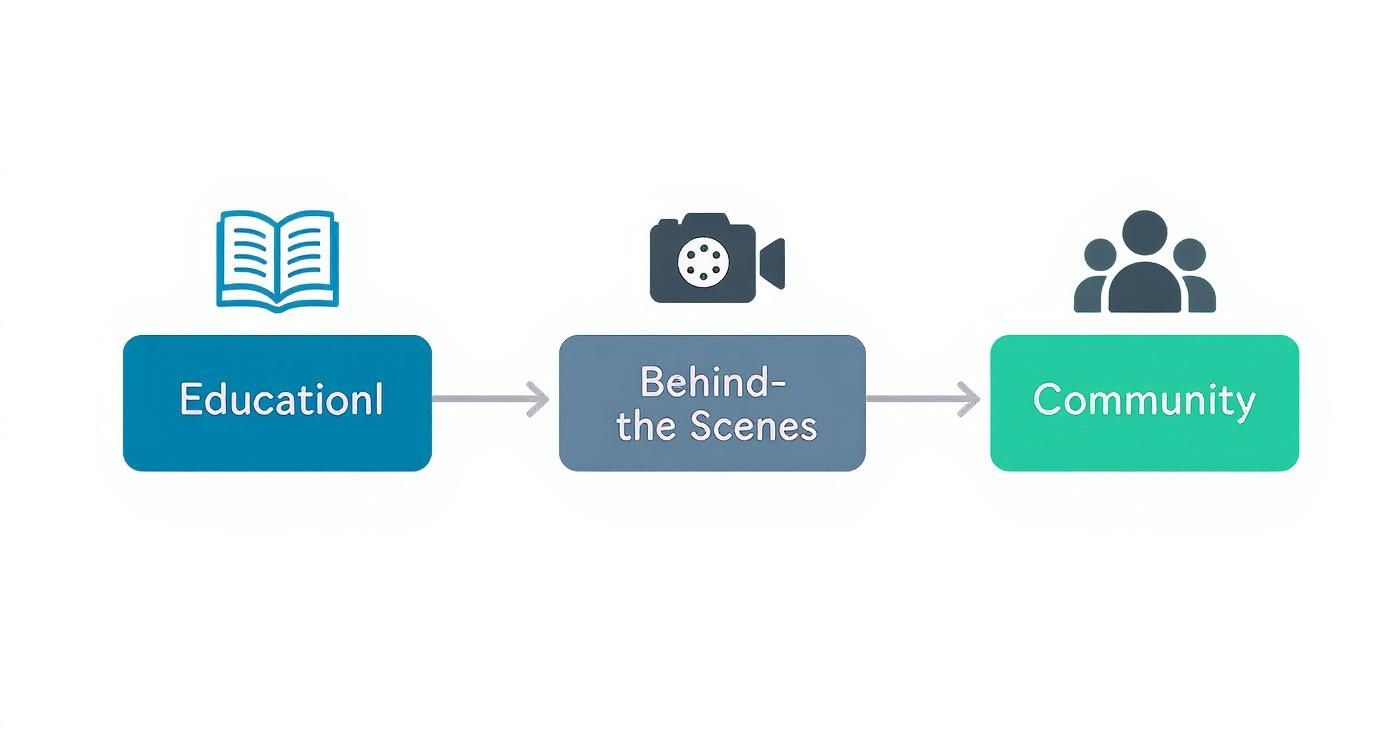A solid content strategy for social media is your roadmap. It’s a detailed plan that guides what you create and share, making sure every single post pushes you closer to your business goals. It’s the difference between posting randomly and using a structured approach that builds a consistent brand, connects with the right people, and actually gets results you can measure.
Why Your Social Media Needs a Real Strategy

Let’s be real for a minute. Posting on social media without a plan feels like shouting into a hurricane. You’re busy, your resources are limited, and sporadic posts just lead to crickets—low engagement and a ton of wasted effort on content nobody sees. Having a structured content strategy isn’t a "nice-to-have" anymore; it's essential for staying relevant and growing.
This guide is designed to take your social media efforts from chaotic to a predictable, growth-focused machine that delivers.
The Challenge of a Crowded Space
Getting noticed out there is tough. By 2025, the number of global social media users is expected to hit around 5.66 billion "user identities." On top of that, the average person is scrolling through nearly seven different platforms every month. That’s a lot of noise to cut through, which is why a targeted strategy is non-negotiable.
Without a clear plan, most businesses run into the same old problems:
- Wasted Resources: You pour time and money into creating content that doesn't connect or even reach the right audience.
- Inconsistent Messaging: A scattered approach creates a confusing brand voice, which chips away at trust and makes you forgettable.
- Low Engagement: Random posts don't build a community or start real conversations. You're left with vanity metrics instead of genuine connections.
- No Measurable ROI: How can you prove social media is working if you don't have clear goals and a system to track your progress toward them?
A great social media strategy isn't just about what you post. It's about why you're posting it, who you're posting it for, and how it helps your business grow. It gives your content direction and purpose.
For a deeper look at modern tactics, you might want to check out these AI-Powered Social Media Engagement Strategies. For now, let's walk through a practical, no-fluff process to build a system that works for you.
Defining Goals That Actually Matter

Before you even think about writing a caption, your content strategy for social media needs a destination. Goals like "get more followers" are the social media equivalent of driving blindfolded. Sure, you're moving, but who knows where you'll end up?
Real success isn't about those flashy numbers. It's about tying your social media efforts to tangible business outcomes. It’s time to look past the vanity metrics. A huge follower count looks great on paper, but it doesn't mean much if those followers don't click, engage, or buy. We need to focus on the key performance indicators (KPIs) that actually move the needle for your business.
Tying Social Goals to Business Objectives
What works for a B2B software company is going to be completely different from what works for a direct-to-consumer (D2C) fashion brand. Their idea of success on social media is worlds apart, and your strategy needs to reflect that reality.
Let's look at a couple of real-world scenarios:
-
For a B2B Company: The ultimate goal is probably generating qualified leads. So, their social media goal isn't just getting likes on a LinkedIn article. It's about driving traffic to a demo request page. Success here is measured by click-through rates, form submissions from social, and the number of marketing-qualified leads (MQLs) that came directly from their social channels.
-
For a D2C Brand: The main objective is almost always driving online sales. The brand’s social media goal is to increase direct revenue from platforms like Instagram. They'll be laser-focused on metrics like conversion rates from their social ads, revenue per visitor, and sales attributed to Instagram Shopping tags.
See the connection? In both cases, there's a straight line from a social media action to a business result. That's how you turn social media from a chore into a revenue-generating machine.
A strong social media goal always answers the "So what?" question. If your goal is "increase Instagram reach by 20%," you need to finish the sentence: "…so that we can drive more qualified traffic to our new product page and increase sales by 5%."
Using the SMART Framework Practically
The SMART framework—Specific, Measurable, Achievable, Relevant, and Time-bound—is an oldie but a goodie for a reason. It forces you to get specific enough to make your goals truly actionable.
Let’s put it into practice and transform a fuzzy goal into a sharp one:
- The Vague Goal: "I want to improve our brand awareness."
- The SMART Goal: "We will increase our brand awareness on LinkedIn by growing our follower count by 15% and achieving 50,000 post impressions per month within the next quarter (Q3). This directly supports our marketing goal of establishing industry authority."
This new version gives you a clear target, a deadline, and a direct link back to a bigger business objective. When you know exactly what success looks like, you can build a content strategy that’s perfectly designed to get you there.
Auditing Your Current Social Media Presence
Before you build a brilliant new social media plan, you have to get real about what you're working with. It's time for a social media audit—a frank, no-holds-barred look at what's actually happening on your accounts. This isn't about feeling bad about what's not working; it's about gathering clues to make smarter moves.
Think of it as a diagnostic. You're trying to figure out what’s connecting with your audience, what’s falling flat, and where the hidden opportunities are. This deep dive will shape everything you do next.
Figuring Out What's Hitting the Mark (and What's Missing It)
First up, pull up your analytics from the last 6 to 12 months. Go straight to your best-performing content, but don't just stop at the vanity metrics. Look for the posts that genuinely moved the needle on the goals you just set.
- Real Engagement: Which posts sparked the most conversations, shares, and saves? Look for patterns. Was it a tutorial video? A behind-the-scenes carousel? A funny, relatable meme?
- Website Clicks: If traffic is your game, which posts sent a flood of visitors your way? Pinpoint exactly what worked—was it a teaser for a new blog post or a direct product link?
- Follower Spikes: Did a specific post or campaign bring in a wave of new followers? That's a huge sign that you've found content that attracts your ideal audience.
Now, do the same for your worst-performing content. Knowing what your audience actively ignores is just as powerful as knowing what they love. For a really thorough breakdown, our guide offers a complete social media audit checklist to make sure you don't miss a thing.
Checking Out the Competition
You don't operate in a vacuum, so your audit needs to include a peek at what your competitors are up to. I'm not talking about copying their every move. Instead, you’re looking for gaps in their strategy—gaps that you can brilliantly fill.
Are they all stuck in a corporate, buttoned-up tone? Maybe your audience is craving something more authentic and personal. Have they completely ignored a platform where you know your customers are hanging out? That's your cue to swoop in and own that space. A key part of this is monitoring your brand's share of voice across social platforms to see where you truly stand.
To help you get organized, here’s a simple checklist you can use to grade your own profiles.
Social Media Audit Checklist
This table provides a structured way to assess your main social media profiles. Go through each area, consider the key question, and give yourself a score from 1 (needs major work) to 5 (excellent).
| Audit Area | Metric/Question to Consider | Your Finding/Score (1-5) |
|---|---|---|
| Profile Consistency | Is your branding (logo, bio, colors) consistent across all channels? | |
| Content Performance | What percentage of posts hit your engagement benchmarks? | |
| Audience Growth | What has your follower growth rate been over the last 6 months? | |
| Engagement Rate | What's your average engagement rate per post? | |
| Post Frequency | Are you posting consistently and at optimal times? |
Once you’ve completed this, you’ll have a much clearer picture of your performance and where you need to focus your efforts.
Your audit is essentially a SWOT analysis for your social media. It clearly lays out your Strengths, Weaknesses, Opportunities, and Threats, giving you a roadmap for what to do next.
By the end of this process, you’ll have hard data on what works. No more guessing. You'll know which content formats resonate, which topics get people talking, and where your biggest growth opportunities lie. This is the foundation you need to build a strategy that delivers real results.
Developing Your Core Content Pillars
Alright, you’ve got your goals locked in and a solid understanding of what’s already working on your social channels. Now for the fun part: building the framework for your entire content strategy. This is where we move away from the daily scramble of "what to post" and start building a system that actually works for you.
The key to this is using content pillars, which you might also hear called content buckets. Think of them as the handful of core themes your brand will consistently own. They’re your secret weapon for creating a balanced mix of content that keeps your audience coming back for more without feeling like they're just being sold to.
What Are Content Pillars Anyway?
Simply put, content pillars are three to five core subjects that sit at the intersection of your brand's expertise, your audience's interests, and your business goals.
The mental shift is powerful. Instead of waking up and thinking, "What am I going to post today?" you'll ask, "Which of my pillars can I create content for today?" This one change makes the whole process feel less chaotic and much more intentional.
A good set of pillars also saves you from the common trap of posting the same type of content over and over. We’ve all seen those accounts that only post sales pitches—it gets old fast. A strategic mix keeps your community engaged and much more receptive when you do share something promotional. If you want to dive deeper into this idea, we've got a full guide on using social media content buckets that breaks it all down.
Bringing Pillars to Life: A Bakery Example
Let’s make this real. Imagine you run a neighborhood bakery. You know your audience is made up of people who love hands-on baking tips, enjoy seeing the magic behind the counter, and want to feel connected to local businesses.
From that insight, you could build out these content pillars:
-
How-To & Educational: This is all about sharing your expertise and providing genuine value. It could be a quick video showing a simple frosting technique, a carousel post on "5 Tips for the Perfect Sourdough," or sharing snippets from a blog post about the science behind a great croissant.
-
Behind-the-Scenes: This is where you build trust and humanize your brand. Think Instagram Stories of bakers starting their day at 4 AM, a messy-but-fun Reel of the team testing a new recipe, or a photo dump from a staff birthday party. It shows the real people behind the pastries.
-
Community Spotlight: This pillar is designed to create a sense of belonging. You could feature photos from customers (with their permission, of course!), shout out the local coffee shop you supply, or run a poll asking followers what seasonal flavor they’re most excited about.
-
Product in Action: This is your "soft sell." Instead of just a sterile photo of a cake, show it in context. Post a shot of a gorgeous wedding cake at an actual wedding, a happy customer grabbing their morning coffee and pastry, or a time-lapse of a complex custom order coming together.
With this framework, one single idea can fuel an entire week of diverse content. That new seasonal scone recipe isn't just one post. It’s a behind-the-scenes video of its creation, an educational carousel on its unique ingredients, and a call for your followers to share photos when they try it.
By defining these pillars, the bakery's social media feed is no longer just a random collection of posts. It becomes a compelling story that educates, entertains, and sells in a way that feels natural. It’s how you build a sustainable content engine that creates a loyal community, one post at a time.
Building Your Evergreen Content Machine
With your content pillars in place, it’s time to start working smarter, not harder. A truly effective content strategy for social media isn’t about constantly creating new content from scratch. The real secret lies in building an evergreen content machine—a system that consistently provides value to your audience with minimal day-to-day effort.
Evergreen content is the stuff that never gets old. It’s your foundational advice, the core principles of your industry, and the deep insights that stay relevant for months, or even years. Think of these as the greatest hits from your content library.
Identifying Your Timeless Topics
First things first, you need to figure out what "timeless" actually means for your specific audience. These are the cornerstone topics people in your niche are always searching for.
Ask yourself a few simple questions:
- What are the foundational questions your customers ask over and over?
- What are the fundamental tips that will always be useful in your industry?
- Which common mistakes do you see beginners make all the time?
Answering these helps you zero in on content with a long shelf life. Instead of chasing fleeting trends, you're creating assets that can be shared again and again, driving traffic and building your authority long after you first hit publish.
This infographic gives a great visual breakdown of how different evergreen content pillars can serve your audience.

As you can see, a balanced mix of educational, behind-the-scenes, and community-focused content is the key to a well-rounded and sustainable strategy.
If you want to go deeper on this, we've put together a comprehensive guide on creating a powerful evergreen content strategy.
Automating Your Evergreen Workflow
Creating great evergreen content is only half the battle. The real magic happens when you automate its distribution. This is where a tool built specifically for this, like EvergreenFeed, becomes a game-changer.
Instead of manually scheduling the same posts over and over, you build a library of your best stuff and let the system do the heavy lifting. The idea is wonderfully simple:
- Add Your Content: Upload your best-performing blog posts, timeless tips, and favorite quotes into different categories or "buckets."
- Set a Schedule: You decide when you want to post from each bucket to your different social accounts. For example, maybe you schedule a "Blog Post" share every Monday and a "Quick Tip" every Wednesday.
- Automate and Recycle: The tool then automatically pulls from your content buckets and shares posts based on your schedule. This keeps your social media profiles active with high-quality content, even when you’re not there.
An automated evergreen system is your safety net. It fills the gaps in your content calendar, keeping your channels active and engaging your audience, even when you're focused on other priorities.
This automated approach is more important than ever. The demand for content is massive; by 2025, some experts predict successful brands will need to produce between 48 and 72 posts per week across their platforms just to stay visible. You can dig into more of these social media trends over on Hootsuite's research blog.
By building an evergreen machine, you establish a consistent baseline of valuable content. This frees you up to focus on timely campaigns, community engagement, and creating your next big thing. It's the very foundation of a sustainable and effective social media strategy.
Your Social Media Strategy Questions, Answered
Even the most well-laid plans hit a few bumps. When you're in the thick of building out a real-world social media strategy, questions are bound to come up. Let's tackle some of the most common ones I hear from people just like you.
Think of this as your go-to FAQ for getting unstuck and moving forward with confidence.
How Often Should I Really Be Posting?
This is the million-dollar question, isn't it? But here’s the unvarnished truth: consistency always beats frequency.
It’s so much better to share three genuinely valuable, high-quality posts a week than to spam your audience with seven rushed, mediocre ones that get zero engagement. Every single thing you post should have a clear purpose that ties back to your goals.
If you’re just starting out and need a baseline, these are some solid starting points. Just remember to let your own data be the final judge.
- Instagram: 3-5 times per week is a great rhythm.
- Facebook: 1-2 times per day tends to work well for most.
- X (formerly Twitter): It's a firehose. 3-5 times per day is pretty standard to stay visible.
- LinkedIn: For a professional crowd, aiming for 3-5 times per week keeps you top-of-mind.
Your best friend here is the native analytics on each platform. Dive in and see when your audience is actually online and engaging—that’s your golden ticket to scheduling for maximum impact.
What Are the Must-Have Tools for My Strategy?
You really don't need a massive, complicated tech stack to make a huge impact. A few smart choices can make all the difference in staying organized and effective.
Here’s a lean and powerful toolkit to get you started:
- A Scheduling Sidekick: You absolutely need something to manage your content calendar. Tools like Buffer or Hootsuite are great all-rounders, while a more specialized tool like EvergreenFeed is a game-changer for automating your best content.
- A Simple Design Tool: You don't need a graphic design degree. A tool like Canva makes it incredibly easy to create professional-looking visuals that stop the scroll.
- Your Built-In Analytics: Don't overlook the free data right at your fingertips! Every platform’s native analytics are surprisingly powerful for understanding what’s working and what’s not.
- A Content Idea Machine: Stuck for ideas? A tool like AnswerThePublic is brilliant for uncovering the exact questions your audience is asking online.
How Do I Actually Measure Social Media ROI?
This one is simpler than it sounds, because it ties directly back to the goals you set in the very beginning. How you measure your return on investment (ROI) depends entirely on what you were trying to accomplish in the first place.
ROI isn't just about the money flowing in. It's about proving that the time and energy you're spending on social media are directly contributing to your business objectives. You have to connect the dots.
If your goal was brand awareness, then your ROI is an increase in reach, impressions, and follower growth. If you were focused on lead generation, you’re tracking click-through rates, how many people converted on your landing page, and your cost per lead. For driving sales, you’ll want to use UTM parameters in your links to see exactly how much revenue your social media posts are generating.
Should I Use AI to Create My Social Media Content?
Think of AI as a brilliant assistant, not a replacement for your brand's soul. You should absolutely use it to speed up your workflow, but never let it take over your authenticity.
AI is fantastic for brainstorming ideas when you're stuck, outlining a post, or getting a rough first draft on paper. But—and this is a big one—you must always review and heavily edit the output. Your job is to inject your unique perspective, your tone of voice, and the personality that makes your brand yours.
Authenticity is what builds a real community. Use AI to get more done, not to automate the human connection right out of your strategy.
Ready to put your evergreen content on autopilot and reclaim hours of your week? EvergreenFeed makes it dead simple to build a library of your best stuff and schedule it automatically, keeping your feeds active and engaging without the daily grind. Sign up for free and start automating today!




